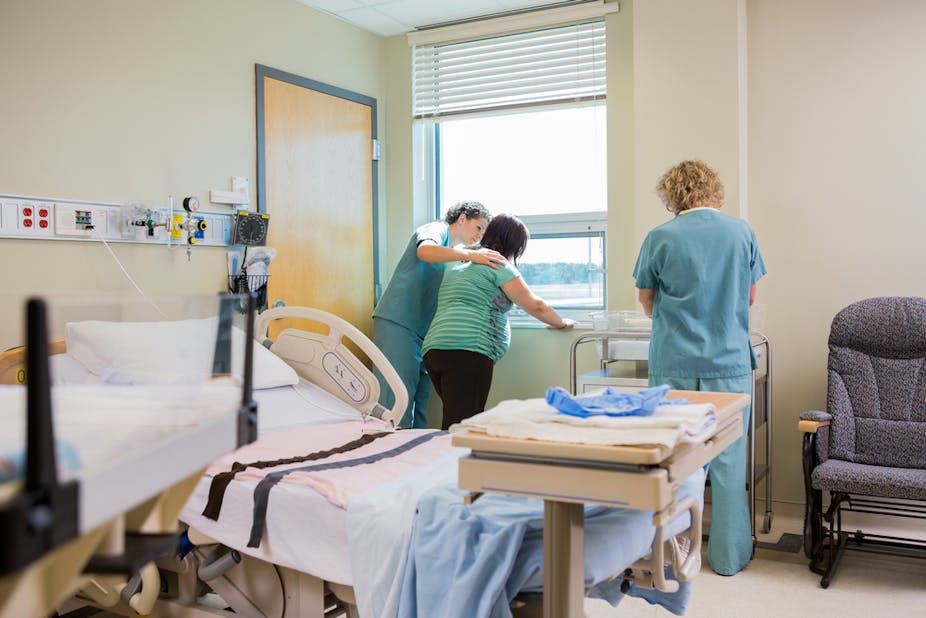In the much-loved British TV drama Call the Midwife, women are offered care from dedicated midwives through pregnancy, labour and birth. The midwives are therefore able to get to know the women and practice their skills with confidence, independence and pride. The show is set in 1950s London but could this also be the future for mainstream maternity care in Australia?
In a recent study, my colleagues and I at the University of Sydney found that pregnant women who see the same midwife throughout pregnancy, birth and the postnatal period are much less likely to experience interventions during birth and cost the public hospital system less.
The study, published last week in BMC Pregnancy and Childbirth, examined the outcomes of a group of first-time mothers who were at low risk of complications during their pregnancies.
Over one financial year (2009-2010), there was an average saving of more than A$1,000 per woman who chose continuity of midwifery care compared to routine public hospital care – where the woman is cared for by the midwife of duty – or private obstetric care in the public hospital system.
Our close neighbour, New Zealand, gives all women the option of a lead midwife care provider and around 80% choose this option. But to date, Australia’s effort has been half-hearted: only a handful of hospitals run a midwifery group practice, offering continuity of care and midwives on call.
Better for women
Caseload midwifery care works on the assumption that women will labour more effectively, have a shorter stay in hospital and feel a stronger sense of satisfaction and personal control if they have the opportunity to get to know their midwife at the beginning of pregnancy.
The BMC Pregnancy and Childbirth study found that those who received continuity of care through a midwifery group practice were significantly more likely to spontaneously go into labour (rather than taking drugs to induce labour) and were less likely to have a cesarean birth. Most women prefer to avoid major intervention in birth, have better outcomes and are more satisfied if they have a normal birth.
There were also no differences in serious outcomes for the babies in this study.

The findings come on the heels of our randomised controlled trial of caseload midwifery published last year in the Lancet medical journal, which found caseload midwifery delivers improvements in outcomes and cost. Women were more likely to start their labour spontaneously, required less pain relief, had short postnatal stays and fewer babies were admitted to neonatal intensive care.
It also follows a 2013 Cochrane Systematic Review which examined 13 randomised controlled trials (over 16,000 women) and showed that compared with a variety of other models, continuity of midwifery led to reduced interventions in birth and, most stunningly, a 23% reduction in babies being born preterm. There were also fewer babies dying before 24 weeks gestation.
The new study is the first to calculate the average cost, per woman, of receiving caseload midwifery compared with private obstetric care in the public system and showed around a A$1,400 cost saving.
Making it a reality
Hospitals are large immovable systems that are very difficult to change – even when the evidence points to the advantages of having a restructured workforce. Managers find it difficult to trust midwives with the flexibility this work requires to enable them to respond to the needs of women in their care.
There is also some resistance among the medical profession. In Australia, around 25% of women will have private obstetric care, which means an obstetrician is the lead care provider during the antenatal period and for the birth. Midwives provide the labour care and postnatal care.
While this gives women continuity of care with an obstetrician, we recently published a paper showing the rates of intervention during birth are much higher under private obstetric care than in the public sector and even higher than when women have continuity of midwifery.

Continuity of midwifery care can no longer be overlooked because it is perceived to be too expensive. With nearly 300,000 births a year in this country, caseload midwifery could potentially save around A$4.5 million dollars per year by reducing medical intervention and reducing hospital stays.
Following the release of the Productivity Commission’s Report, Health Minister Peter Dutton last month called for an overhaul in health spending to cut “waste”. With a finite health budget we can no longer afford to be complacent.
Women should be able to choose an obstetrician; these medical specialists provide an indispensable service in maternity care. But based on the evidence of better outcomes and lower cost, women should have the option of calling the midwife.

